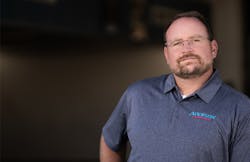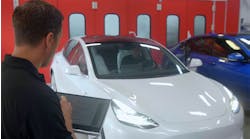SHOP STATS: Addison Collision Repair Location: Twins Falls, Idaho Operators: Justin Simmons and Jared Povey Average Monthly Car Count: 125 Staff Size: 19 Shop Size: 10,000 sq ft; Annual Revenue; $4.4 million
Joe Nalder was asked to accept a position of project manager at Addison Collision Repair after he finished a complete remodel on their office. It was around late 2008 and the housing market had just dropped off, which put a dent in the business his woodworking company brought in.
Nalder was shocked, but owners Justin Simmons and Jared Povey—Nalder’s college friends—knew there was something special about Nalder. He knew how to manage projects and people.
“It was super intimidating,” Nalder says. “I had never worked in the industry and when they asked me to be the direct manager for this group of people, they assured me that I’d pick up on it.”
He agreed to start the new role, leaving behind a career in woodworking, and became the business’ project manager in 2009. Since his arrival, his roles have morphed greatly; in the beginning, Nalder helped technicians with supplements and had limited access to the full business.
“Now, on the average day, I run, at this point, all operations,” Nalder says.
Today, Nalder operates as the shop’s general manager, and has found that the key to finding success in the shop is by shining a light on all of the talent. In order for employees to grow, they need to be encouraged and educated, much like he was during the beginning of his role at the shop.
“I think one of the biggest lessons that I’ve learned is that this industry does not have a lot of confidence in themselves,” Nalder says. “What I focus on and what I specialize in is finding what people’s strengths are and teaching them efficiency.”
The first thing I do in the morning is say “hi” to everyone. I’ll take a stroll through the office to make sure everyone is here and I’ll say “hi” to the staff up front, and, eventually, walk through each department. I think it’s important to have a presence in the office because I believe it’s important to show you care about your employees.
Usually, in the morning, the guys are unmasking the vehicles and looking at what was painted the night before. We start painting vehicles early in the morning, so I’ll stop by the paint department and see if anyone needs my assistance. Afterward, I’ll walk through every department to make sure they know I’m available if anyone needs any hands-on assistance.
The last department I usually check out is the DFR department; the team works on disassembling and reassembling vehicles, so there’s several people and lots of vehicles in the room. I’ll go through and visit with each one of them in the morning to touch base.
Every morning at 8:30, we have a staff meeting. Essentially, this means that our key people from the shop—our parts manager, repair planner, DFR, and some body technicians—will meet together. We meet and discuss what vehicles are coming in for the day and how the day before went. My CSR has everything ready for us during the meeting: the shop’s schedule, customer names, the hours, insurance companies, and just an overall track of who is coming in for the day.
During the meeting, we talk about any decisions that need to be made for the day. It’s nice to get everything out there in the beginning. Afterward, I let our front desk staff know what we went over for the day. We go over what cars need to be updated or if we’ve encountered a problem on the shop floor, and they start making phone calls to the vehicle owners.
Lastly, I speak with the owners about what is going on with the shop—any decisions that need be made will be discussed right away in the morning.
A majority of my time is spent on the floor trying to be the shop’s mentor. Everyone is entitled to their own opinions, but I try to find ways to teach people about decision making. There is a process for everything, and sometimes it’s a clear answer, whereas, other times, you have to work to find the solution. I’ve always believed that there’s plenty of opportunity for training, and I try to exercise training opportunities throughout the shop whenever I can.
We actually have training sessions pretty regularly at the shop. I usually tell everyone to huddle around and we go through what can be fixed. There’s lot of information and understanding that needs to be done when working with vehicle technology and we try to get everyone to work on different projects.
We gather around, handpick people in the shop and go over a fix as a way to educate everyone efficiently. There are a lot of things that go on in vehicle electronics, as far as advanced driver-assistance systems, so that’s always an example we go over with the staff. I’ll have two technicians come from a test drive and report about a driver system, and I’ll pair them together again so they can learn the process. Information is the most valuable thing we have, so why hold it hostage?
I try to focus on finding people’s strengths and teaching them efficiency around the shop. For example, I’ve worked with our repair planner and I’ve taught him how to read procedures so that we are charging for a complete repair and we can prove and document the repair.
There are a lot of lessons I’ve learned in this industry and I believe it comes with experience. I’ve learned that most people are not confident in this industry. I’m not sure why. When I started working with these guys, I realized that they were not confident in the work they did. They weren’t sure of what they could accomplish with the procedures they had in place. We’ve spent the last year working on education among staff members and I believe they’ve found confidence in their work through our training practices.
We have worked hard to improve our shop and the quality service we offer our customers. Our DFR department is really the nuts and bolts of what our company is now. Everything starts with the DFR department; they are responsible for finding what the vehicle’s damage is and how to fix the damage. It’s important to not only focus on the physical damage, but look internally, as well. Once we’re able to able to discover damage using scan tools, we relay the information to those up front.
I always say that everything in our shop reaches out and touches one another; we offer a text messaging service to customers and we also are lucky enough to have bilingual staff members in our company, as well. When a customer comes in for a repair, we want communication to be transparent and honest in order to provide them with the best service. Everything we do here makes an impact.
At the end of the day, I usually tend to our customers and employees. I’m here to answer any questions they may have regarding a repair or I try to be the one who goes over their bill if they have any concerns. I make sure that I am here for them and the staff members.
Before we all head out, I’ll have my shop foreman go through each department and count each vehicle that has been processed. We have a goal of each department tending to at least six cars per day in order for other departments to have work the following day. We try really hard to keep a balance here.
I try to stay here until the last car leaves because I want to be available if a customer or staff member needs me.




